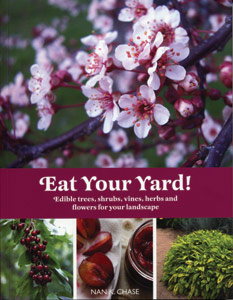Editor's note: This column marks the return of our gardening and agriculture feature, The Dirt, which was hibernating during the winter. But we'd like to plant a new seed: The section could use a new, short and catchy, but descriptive name. Got ideas?
Eat Your Yard!
I miss fresh figs.
Sure, sometimes you can snag a half-pint of them at local groceries. But they tend to be big and bland. They're no substitute for the taste-of-summer figs I'd pick right off the huge tree at my grandmother's south-Alabama home when I was a kid.

Local author Nan K. Chase reminded me of those figs: On a recent snowy, February weekend, I perused her new book, Eat Your Yard! (Gibbs Smith, 2010). It's an enticing work, as Chase mixes stories of her California childhood (backyard plums and almonds) with recipes (Nan's blueberry jam) and layers it all with scenes and tales of her adopted home, Western North Carolina (apple blossoms and black walnuts). Rich photos also grace the book, from lavender grown at a Burnsville farm to an incredibly large pecan tree in Texas that dwarfs the horse and rider posing in front of it.
"I love the fact that my yard feeds me," Chase writes in the book's introduction. "The edible yard," she continues, "combines beauty and practicality: beautiful form in the garden with bounteous crops to eat fresh or preserve for year-round enjoyment." She details favorite fruits such as cherries and apples, noting which growing conditions, nutrients and climates suit each one. It's no surprise to WNC residents that apples like temperate zones with cold winters or that peaches prefer points south and much warmer. Chase also notes how fruit trees fit in the landscape: Cherries need full sun; crabapple trees are typically small and fit in small yards; quince trees provide "winter interest as snow settles onto the tangled limbs."
Fig trees, Chase explains in a chapter titled "Hot-Country Choices," can "grow in cooler climates if they are planted against a sunny wall or insulated for winter, although they might not … bear reliably."
Snow fell while I read about growing figs. Having neither a big greenhouse nor a proper sunny wall, I'll probably have to stick to dried figs and jams to get my taste of nostalgia. But fortunately, Chase offers a variety of edible-landscape choices for a variety of climates, and she includes such favorites as sunflowers — grown both for their seeds and for their sunny dispositions as a landscape addition — or such old-timey, near-forgotten fruits as paw-paws. With spring around the corner, let the edible yard begin.
Nan K. Chase will be hosting a session at the upcoming Organic Growers School (see below).
— Margaret Williams
Organic Growers School March 6-7 at UNCA
Registration is now open for the upcoming Organic Growers School Spring Conference that will be held at UNCA on Saturday and Sunday, March 6 and 7. This year, the OGS is offering more than 100 classes and workshops. More than 1,300 farmers, gardeners, activists and consumers are expected to gather for the Southeast's largest sustainable-living conference.

Workshops will cover topics ranging from cover crops to vermi-composting, from pest management to year-round growing. Workshops include "Beautiful and Delicious: Designing a Productive Edible Landscape" and "Organic Farming: What to Expect Your First Year."
In addition to classes on organic gardening and farming, workshop categories include alternative crops, cooking, sustainable forestry, permaculture and herbs. Classes range from growing truffles to making maple syrup, and cover a wide range of experience levels — novice through advanced.
Most of the workshops run for an hour and 30 minutes, but hands-on half-day workshops are also offered. These will allow participants to get direct experience in areas such as edible weeds and natural beekeeping, to name just a couple. One highlight this year, says Coordinator Meredith McKissick, will be a workshop on raising heritage poultry with national poultry expert Jim Adkins. For more than 30 years, Adkins has raised some 50 breeds and varieties of poultry, including chickens, geese, ducks and turkeys.
New to the OGS this year, "Salon Revivals" are offered the evening of Saturday, March 6. The salons will be gatherings at downtown spots — The Dripolator, Firestorm Café and Nest Organics — to discuss and learn about social, political and cultural activism related to organic agriculture. Topics include food safety, accessibility of organics and farm-to-table programs in school — a hot topic in light of First Lady Michelle Obama's recent campaign against childhood obesity. The salons are free and open to the public.
And for the kids, the OGS is offering a daylong children's program where youngsters will learn with activities and music.
General registration is $55 per day. The children's program is for kids ages 7 to 12 and costs $30 per day. Half-day workshops and cooking classes are an additional $5 each. For more information and to register, go to www.organicgrowersschool.org.
In related news, the OGS is looking for a farmer-programs outreach-and-development assistant who will report to the organization's farmer-education committee. Go here for details: http://bit.ly/cWm5gd.
— Robin Criscuolo



Before you comment
The comments section is here to provide a platform for civil dialogue on the issues we face together as a local community. Xpress is committed to offering this platform for all voices, but when the tone of the discussion gets nasty or strays off topic, we believe many people choose not to participate. Xpress editors are determined to moderate comments to ensure a constructive interchange is maintained. All comments judged not to be in keeping with the spirit of civil discourse will be removed and repeat violators will be banned. See here for our terms of service. Thank you for being part of this effort to promote respectful discussion.